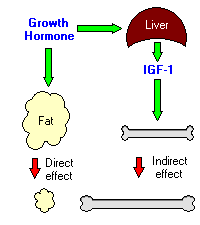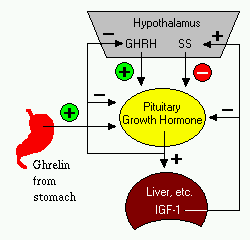Physiologic Effects of Growth Hormone
A critical concept in understanding growth hormone activity is that it has two distinct types of effects:
- Direct effects are the result of growth hormone binding its receptor on target cells. Fat cells (adipocytes), for example, have growth hormone receptors, and growth hormone stimulates them to break down triglyceride and supresses their ability to take up and accumulate circulating lipids.
- Indirect effects are mediated primarily by a insulin-like growth factor-I (IGF-I), a hormone that is secreted from the liver and other tissues in response to growth hormone. A majority of the growth promoting effects of growth hormone is actually due to IGF-I acting on its target cells.

Keeping this distinction in mind, we can discuss two major roles of growth hormone and its minion IGF-I in physiology.
Effects on Growth
Growth is a very complex process, and requires the coordinated action of several hormones. The major role of growth hormone in stimulating body growth is to stimulate the liver and other tissues to secrete IGF-I. IGF-I stimulates proliferation of chondrocytes (cartilage cells), resulting in bone growth. Growth hormone does seem to have a direct effect on bone growth in stimulating differentiation of chondrocytes.
IGF-I also appears to be the key player in muscle growth. It stimulates both the differentiation and proliferation of myoblasts. It also stimulates amino acid uptake and protein synthesis in muscle and other tissues.
Metabolic Effects
Growth hormone has important effects on protein, lipid and carbohydrate metabolism. In some cases, a direct effect of growth hormone has been clearly demonstrated, in others, IGF
-I is thought to be the critical mediator, and some cases it appears that both direct and indirect effects are at play.
Protein metabolism: In general, growth hormone stimulates protein anabolism in many tissues. This effect reflects increased amino acid uptake, increased protein synthesis and
decreased oxidation of proteins.
Fat metabolism: Growth hormone enhances the utilization of fat by stimulating triglyceride breakdown and oxidation in adipocytes.
Carbohydrate metabolism: Growth hormone is one of a battery of hormones that serves to maintain blood glucose within a normal range. Growth hormone is often said to have anti-
insulin activity, because it supresses the abilities of insulin to stimulate uptake of glucose in peripheral tissues and enhance glucose synthesis in the liver. Somewhat paradoxically, administration of growth hormone stimulates insulin secretion, leading to hyper-insulinemia.
Control of Growth Hormone Secretion
Production of growth hormone is modulated by many factors, including stress, exercise, nutrition, sleep and growth hormone itself. However, its primary controllers are two hypothalamic hormones and one hormone from the stomach:
Growth hormone-releasing hormone (GHRH) is a hypothalamic peptide that stimulates both the synthesis and secretion of growth hormone. Somatostatin (SS) is a peptide produced by
several tissues in the body, including the hypothalamus. Somatostatin inhibits growth hormone release in response to GHRH and to other stimulatory factors such as low blood
glucose concentration. Ghrelin is a peptide hormone secreted from the stomach. Ghrelin binds to receptors on somatotrophs and potently stimulates secretion of growth hormone.
Growth hormone secretion is also part of a negative feedback loop involving IGF-I. High blood levels of IGF-I lead to decreased secretion of growth hormone not only by directly
suppressing the somatotroph, but by stimulating release of somatostatin from the hypothalamus.
Growth hormone also feeds back to inhibit GHRH secretion and probably has a direct (autocrine) inhibitory effect on secretion from the somatotroph. Integration of all the factors that affect growth hormone synthesis and secretion lead to a pulsatile pattern of release. Basal concentrations of growth hormone in blood are very low. In children and young adults, the most intense period of growth hormone release is shortly after the onset of deep sleep.
Growth hormone is currently approved and marketed for enhancing milk production in dairy cattle. There is no doubt that administration of bovine somatotropin to lactating cows
results in increased milk yield, and, depending on the way the cows are managed, can be an economically-viable therapy. However, this treatment engenders abundant controversy,
even among dairy farmers. One thing that appears clear is that drinking milk from cattle treated with bovine growth hormone does not pose a risk to human health.
Another application of growth hormone in animal agriculture is treatment of growing calves with trenbolone acetate, estradiol benzoate, testosterone propionate, and some other growth hormones. Such treatment has been demonstrated to significantly stimulate muscle growth and reduce deposition of fat.

No comments:
Post a Comment